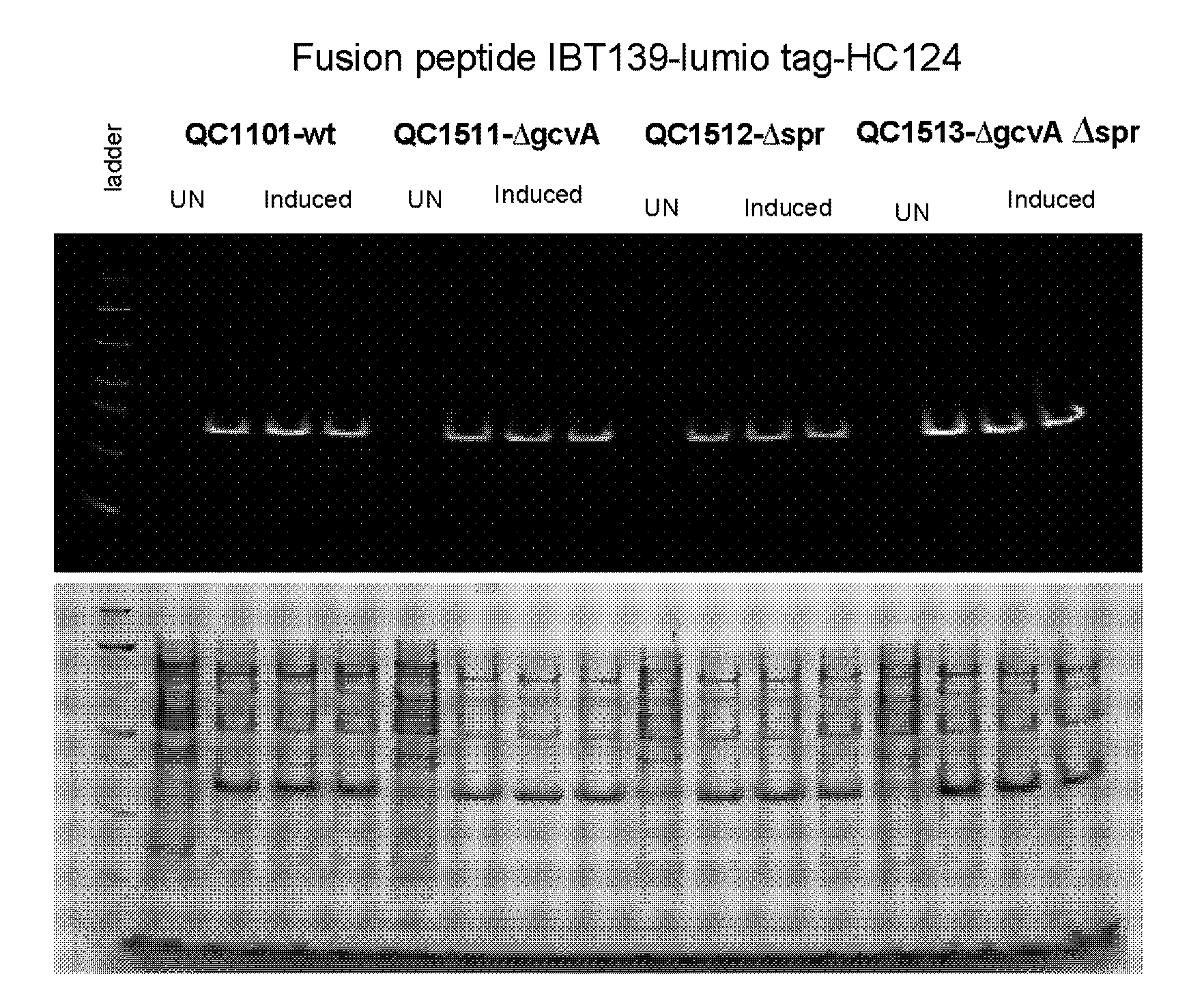Host cell modifications that improve peptide production and downstream processing
a technology of host cell and peptide, which is applied in the field of molecular biology, microbiology and recombinant peptide production, can solve the problems of limited production capacity, reduced yield, and high cost of methods, and achieve the effect of improving downstream processing parameters and improving peptide production
- Summary
- Abstract
- Description
- Claims
- Application Information
AI Technical Summary
Benefits of technology
Problems solved by technology
Method used
Image
Examples
example 1
Construction and Sorting of a Transposon Insertion Library
[0217]This example describes construction of a transposon insertion library in a peptide production strain QC1101, which produced fusion peptide that contained the tetracysteine tag (CCPGCC; SEQ ID NO: 1). The tetracysteine tag allowed specific labeling of the fusion peptide by fluorescein derivative of biarsenical ligands FlAsH-EDT2 (LUMIO™ Green), and sorting of the library by fluorescence on FACS. The LUMIO™ reagents were obtained from Invitrogen (Carlsbad, Calif.).
[0218]The transposon insertion library was constructed in a peptide production strain QC1101, which expressed the fusion peptide consisted of the small inclusion body tag IBT139 (SEQ ID NO: 3), the tetracysteine tag (SEQ ID NO: 1) followed by the peptide of interest HC776124 (SEQ ID NO: 4). The Tn5-KAN transposome from Epicentre Technologies (Madison, Wis.) was used for the transposon mutagenesis with QC1101 strain following manufacturer's instruction. Approxima...
example 2
Sequencing of the Sorted Clones
[0220]The transposon insertion site in each of the mutant was mapped by genomic sequencing using the ILLUSTRA™ GENOMIPHI™ v2 DNA Amplification kit from GE Healthcare (Piscataway, N.J.). The primers to sequence the chromosomal junction of both ends of the transposon were:
Kan2cb-For(5′-CTGGTCCACCTACAACAAAGCTCTCATC-3′; SEQ ID NO:13)andkan2cb-Rev(5′-CTTGTGCAATGTAACATCAGAGATTTTGAGACACAC-3′; SEQID NO: 14).
The mutants selected for further analysis are listed in Table 3.
[0221]Among the sequenced clones, the highest number of hits was in the ftsN gene. Nine different ftsN mutants were obtained with the transposon inserted at different locations of the ftsN gene in different orientations. The ftsN gene was reported to be involved in cell division (Yang, J. C., et al. (2004), Mol. Micro. 52:651; Goehring, N. W., et al., (2007), J. Bacteriol. 189:646) and the higher fluorescence of the ftsN mutants might be an artifact of sorting as a result from defective cell di...
example 3
Confirmation of FACS Analysis with Clean Deletion Mutants
[0224]To verify that the genes interrupted by the transposon insertions were responsible for the phenotypes, clean mutants were reconstructed that contained the in-frame deletion of the particular single genes interrupted by the transposon insertions. A collection of the E. coli K12 in-frame single gene knockout mutants was used (“Keio collection”; Baba, T., et al., supra). The particular Keio knockout strains that corresponding to the transposon insertion mutants (see Table 3) were streaked out from the collection on LB containing kanamycin (25 μg / mL) plates. P1 lysates were prepared by growing P1c / r100 Cm phage with the individual Keio strains (Miller, J. H., (1972), Experiments in Molecular Genetics. Cold Spring Harbor Laboratory, Cold Spring Harbor, N.Y.). The phage lysates were then used to transduce the control strain QC1100. Mutants that contained the gene knockouts of interest were selected on kanamycin plates and conf...
PUM
| Property | Measurement | Unit |
|---|---|---|
| Volume | aaaaa | aaaaa |
| Volume | aaaaa | aaaaa |
| Volume | aaaaa | aaaaa |
Abstract
Description
Claims
Application Information
 Login to View More
Login to View More - R&D
- Intellectual Property
- Life Sciences
- Materials
- Tech Scout
- Unparalleled Data Quality
- Higher Quality Content
- 60% Fewer Hallucinations
Browse by: Latest US Patents, China's latest patents, Technical Efficacy Thesaurus, Application Domain, Technology Topic, Popular Technical Reports.
© 2025 PatSnap. All rights reserved.Legal|Privacy policy|Modern Slavery Act Transparency Statement|Sitemap|About US| Contact US: help@patsnap.com



